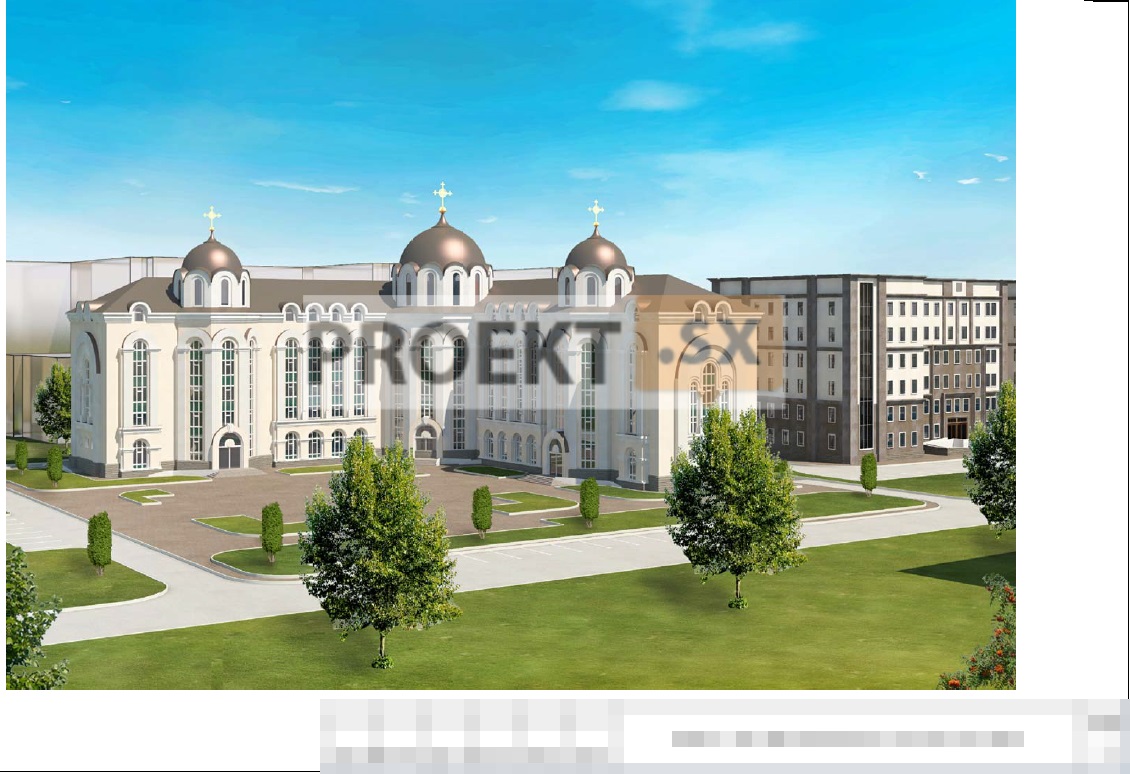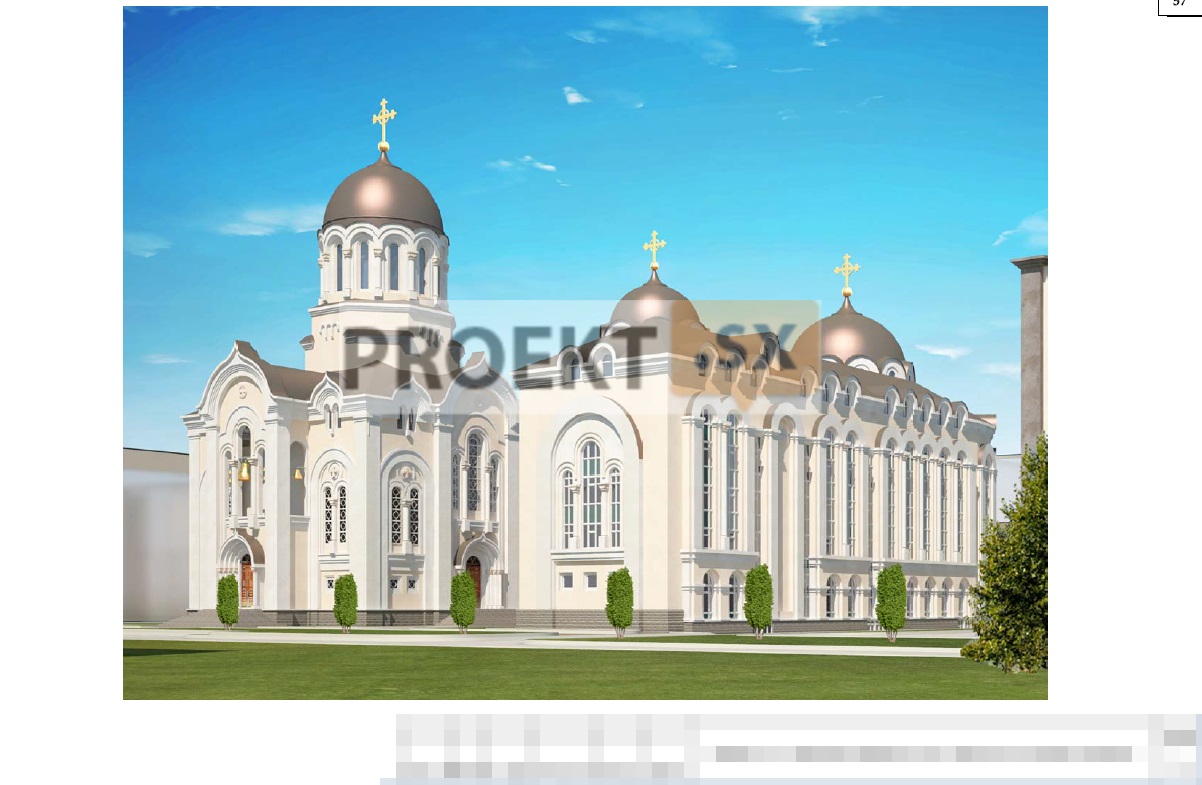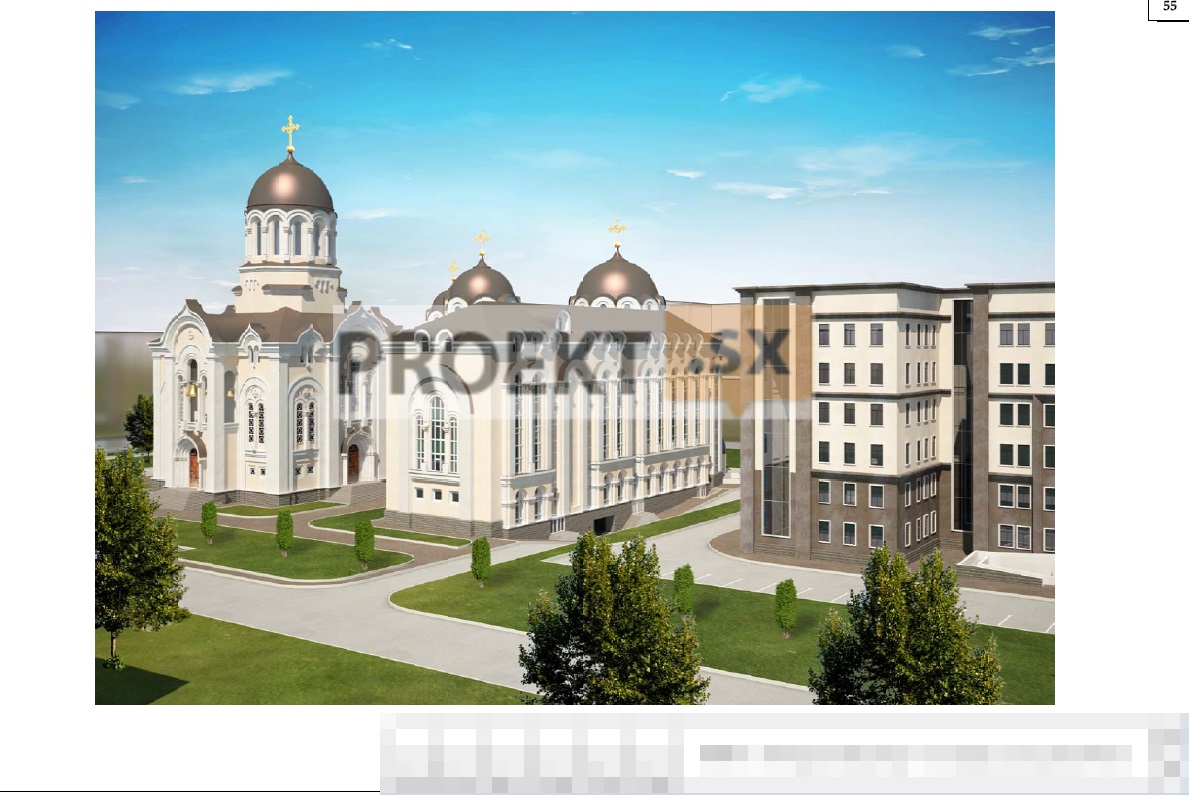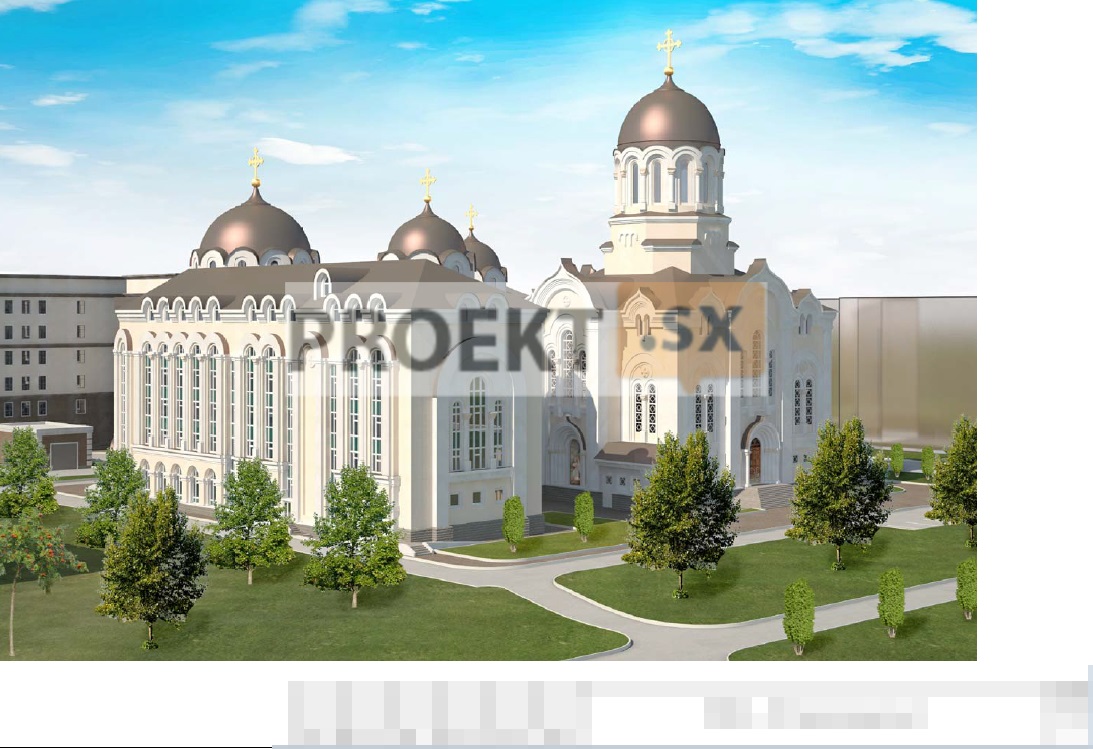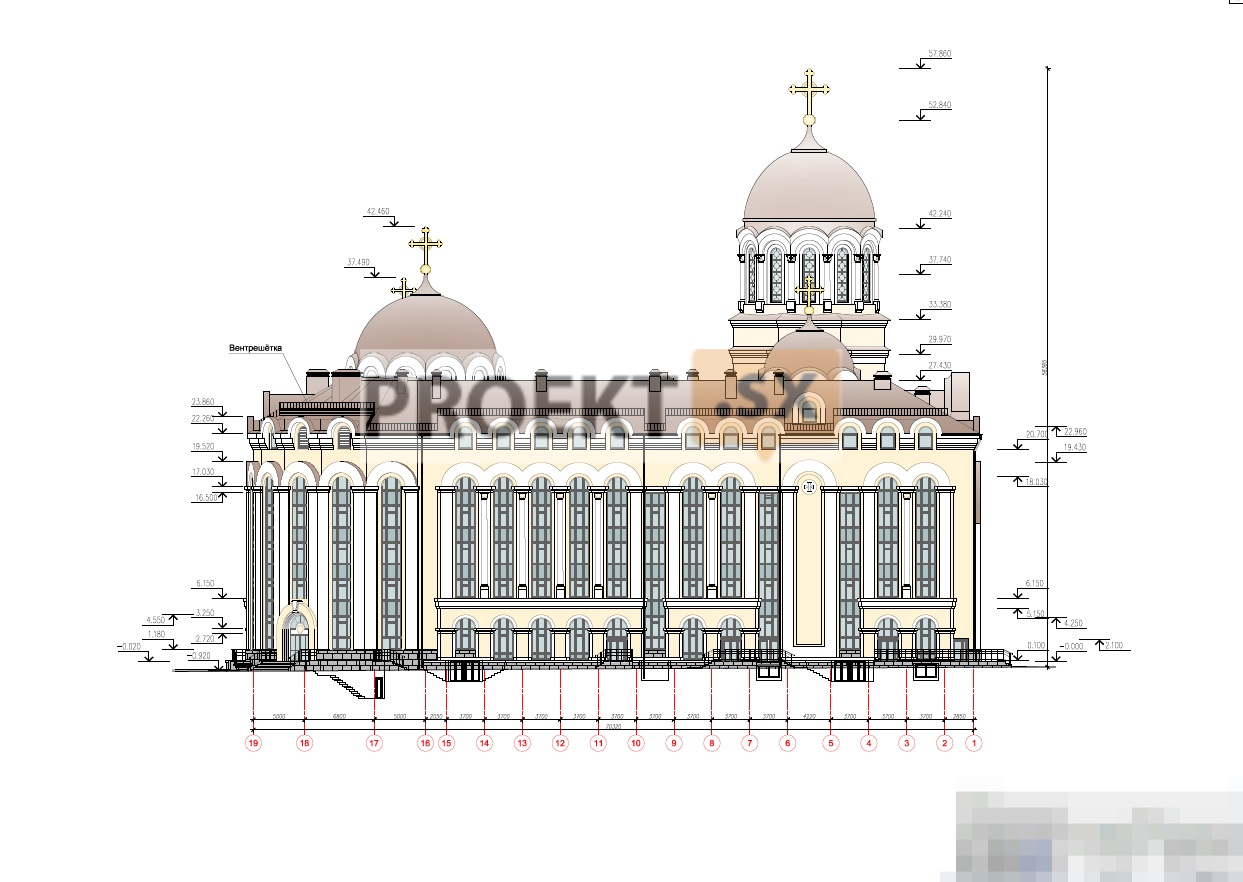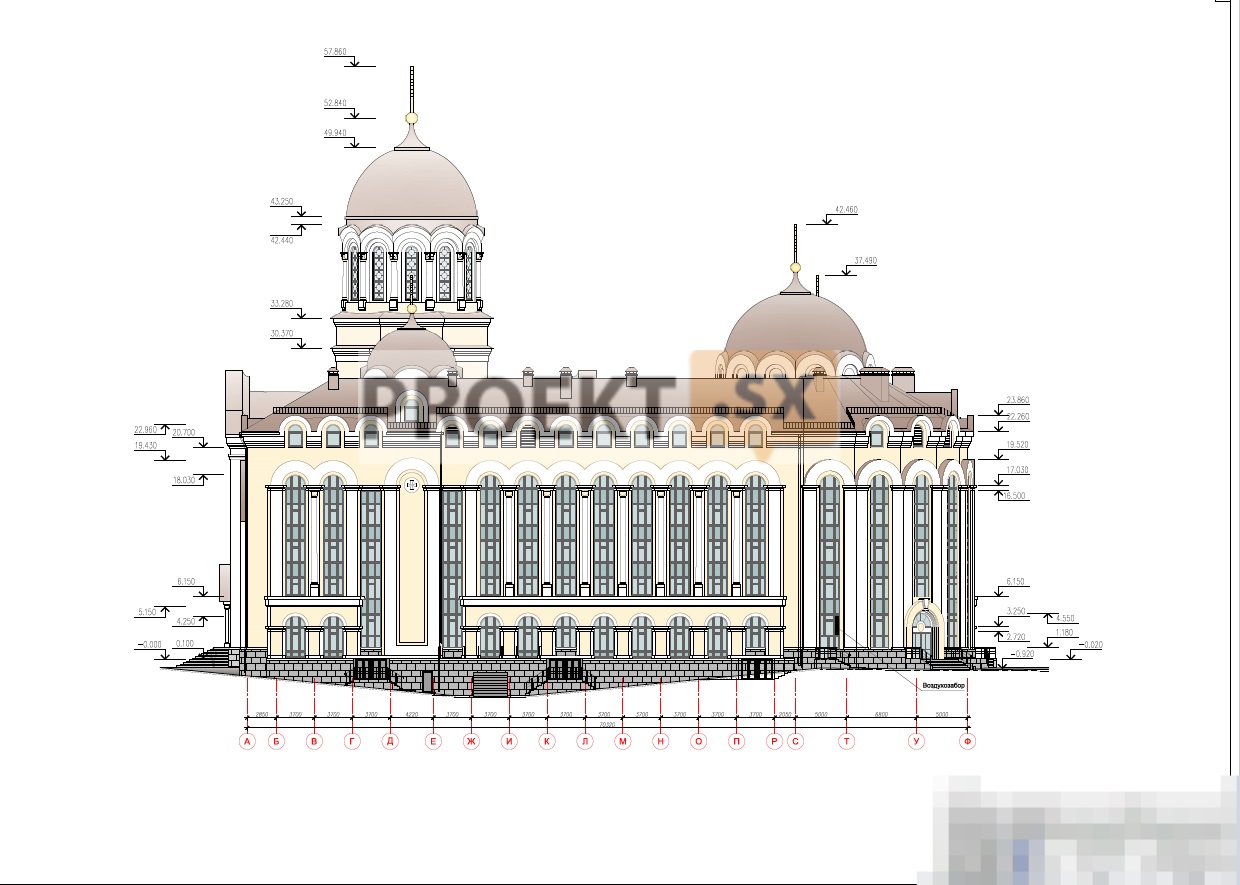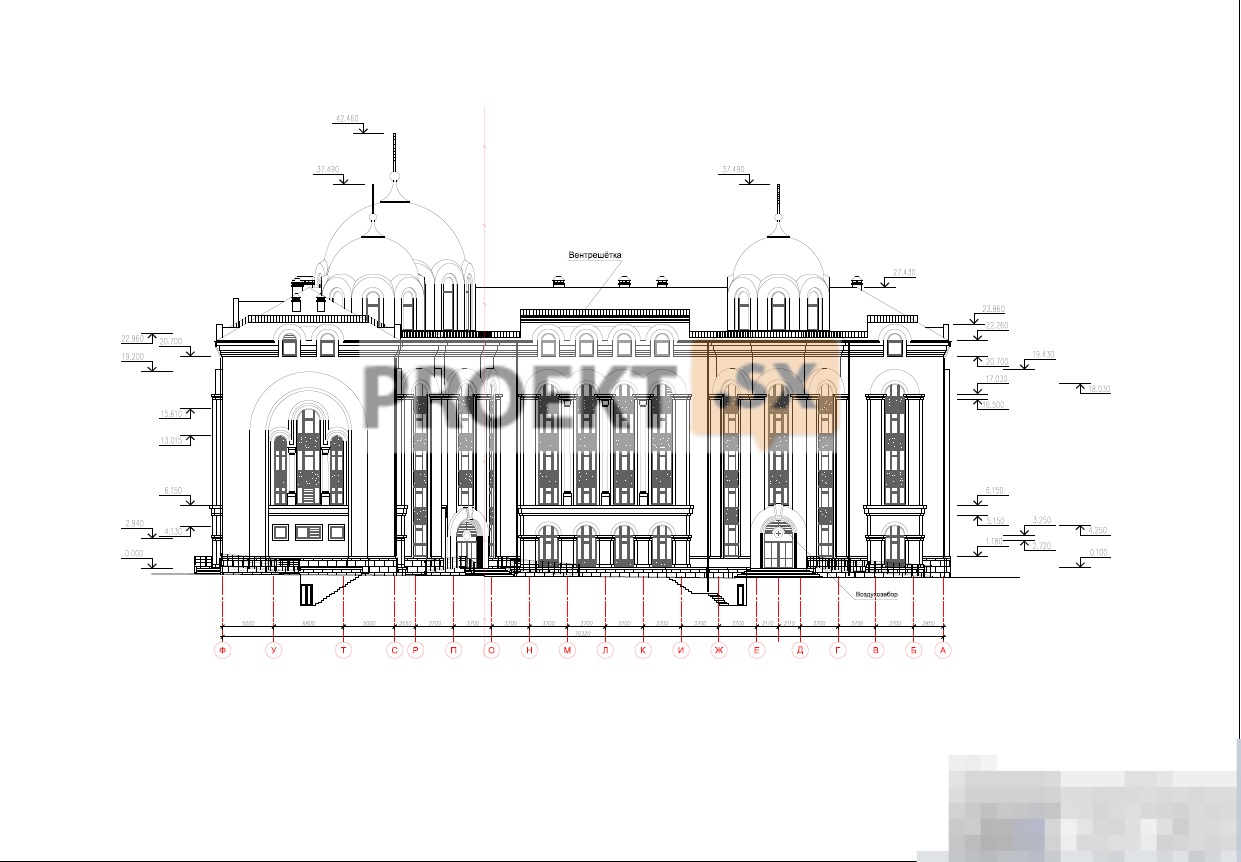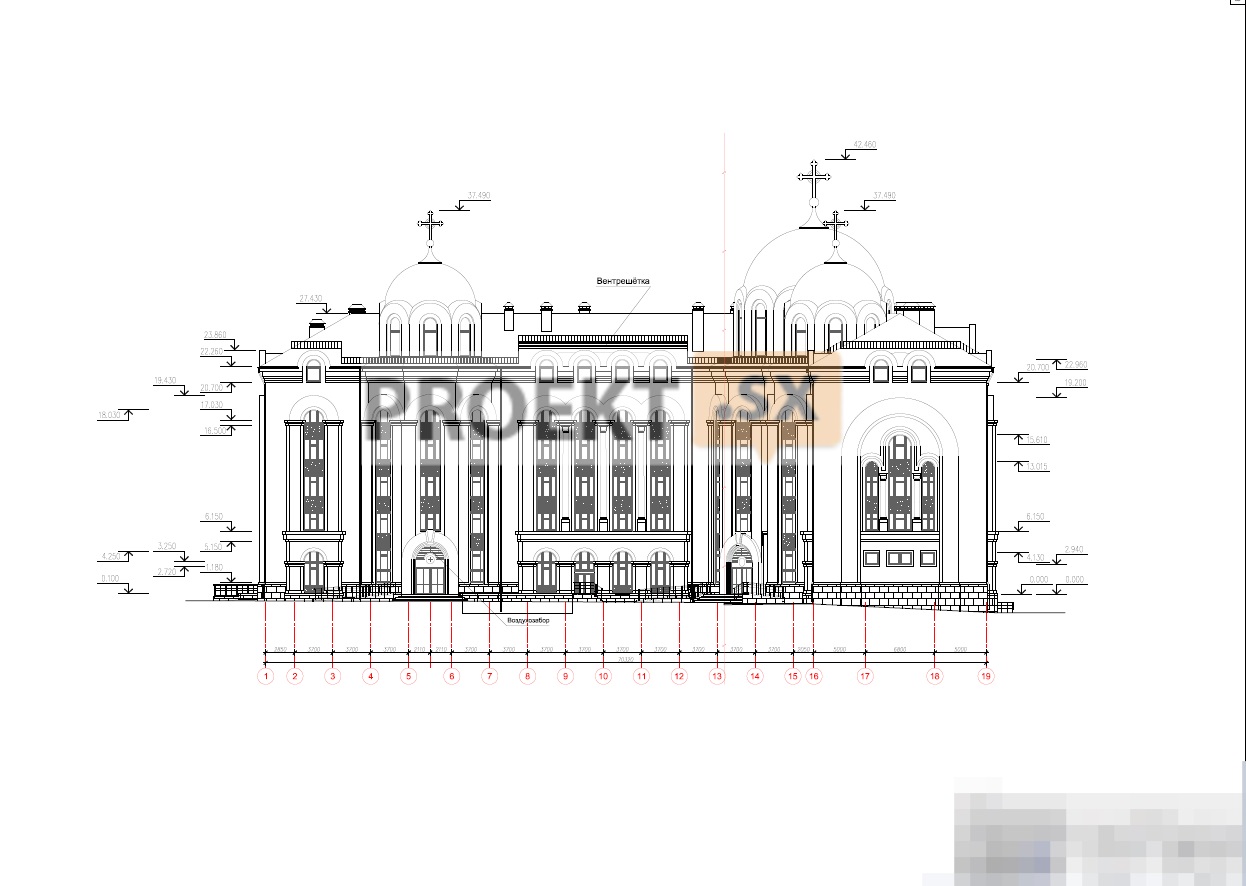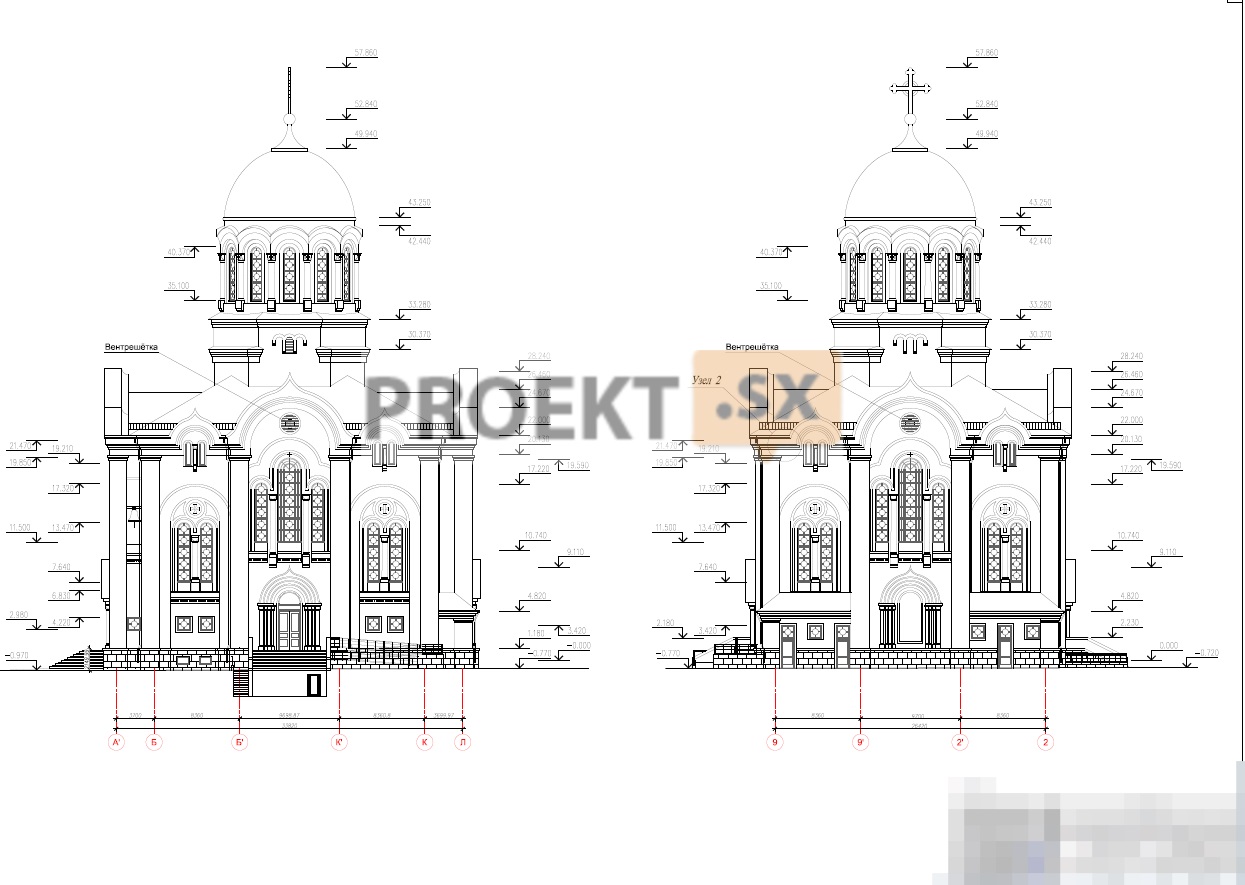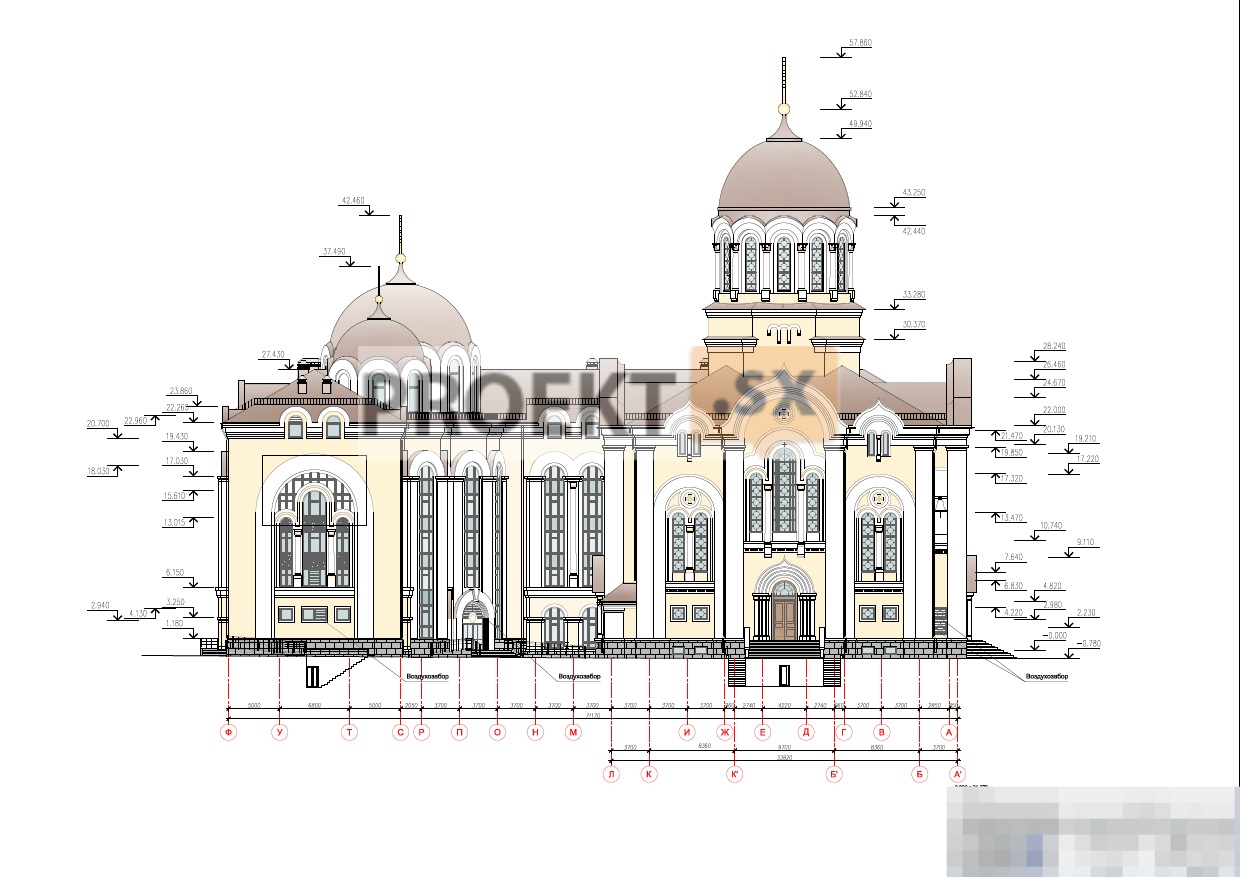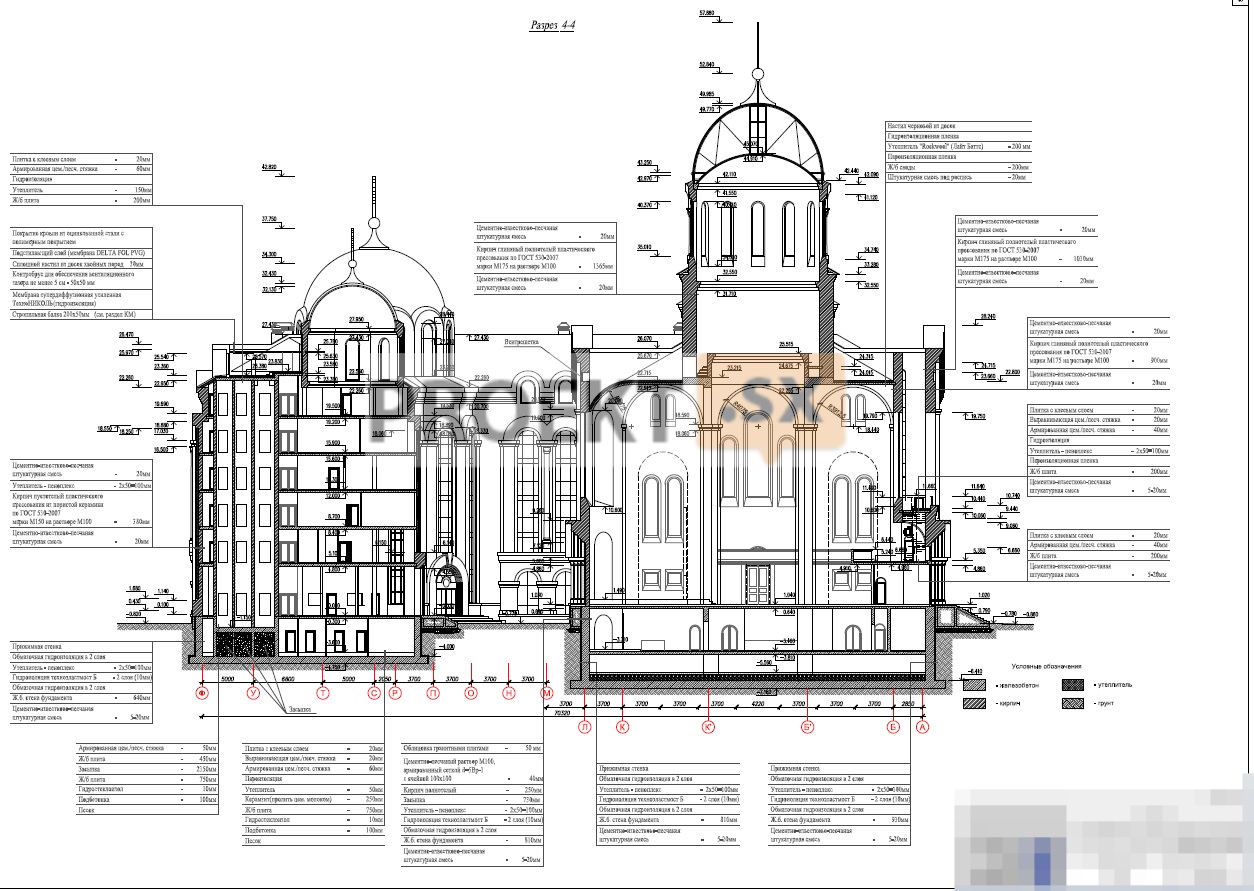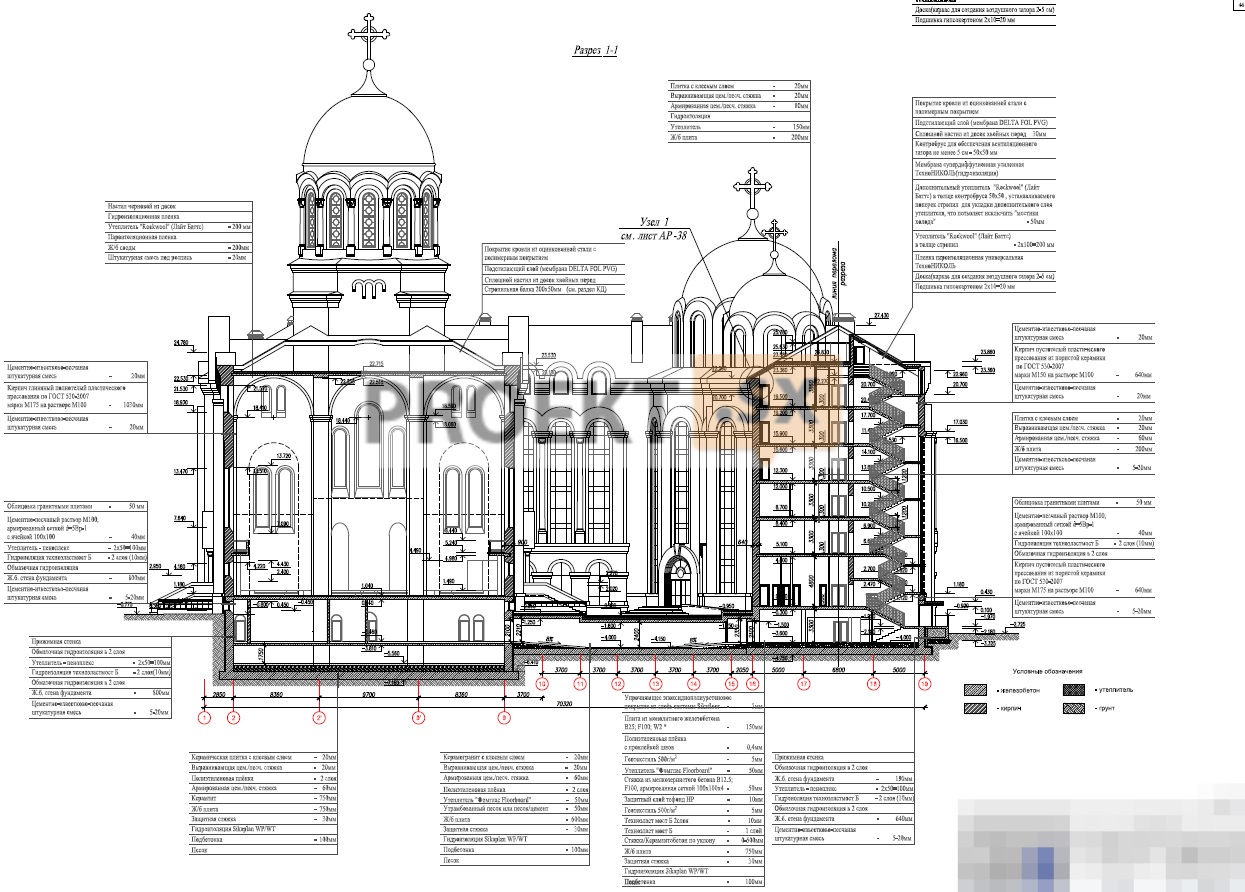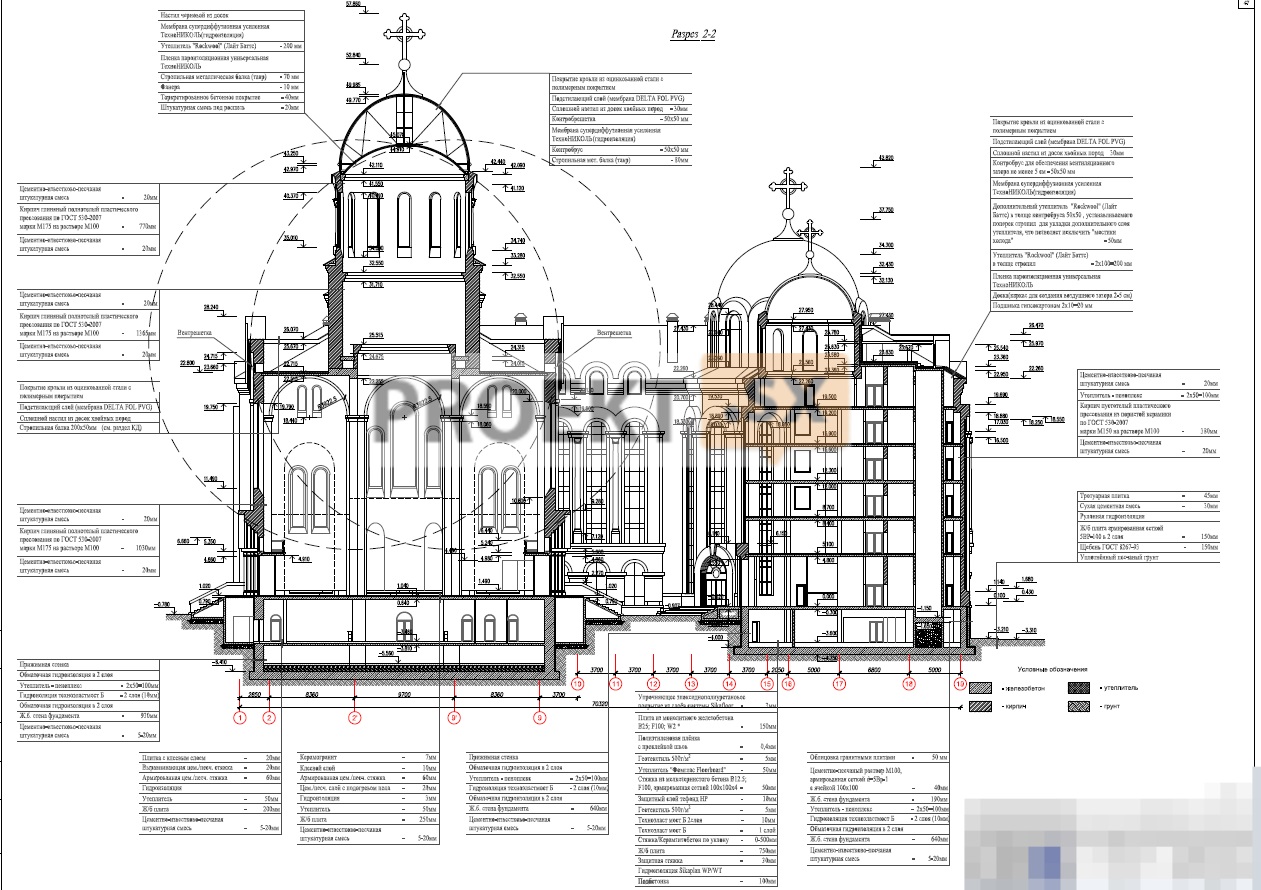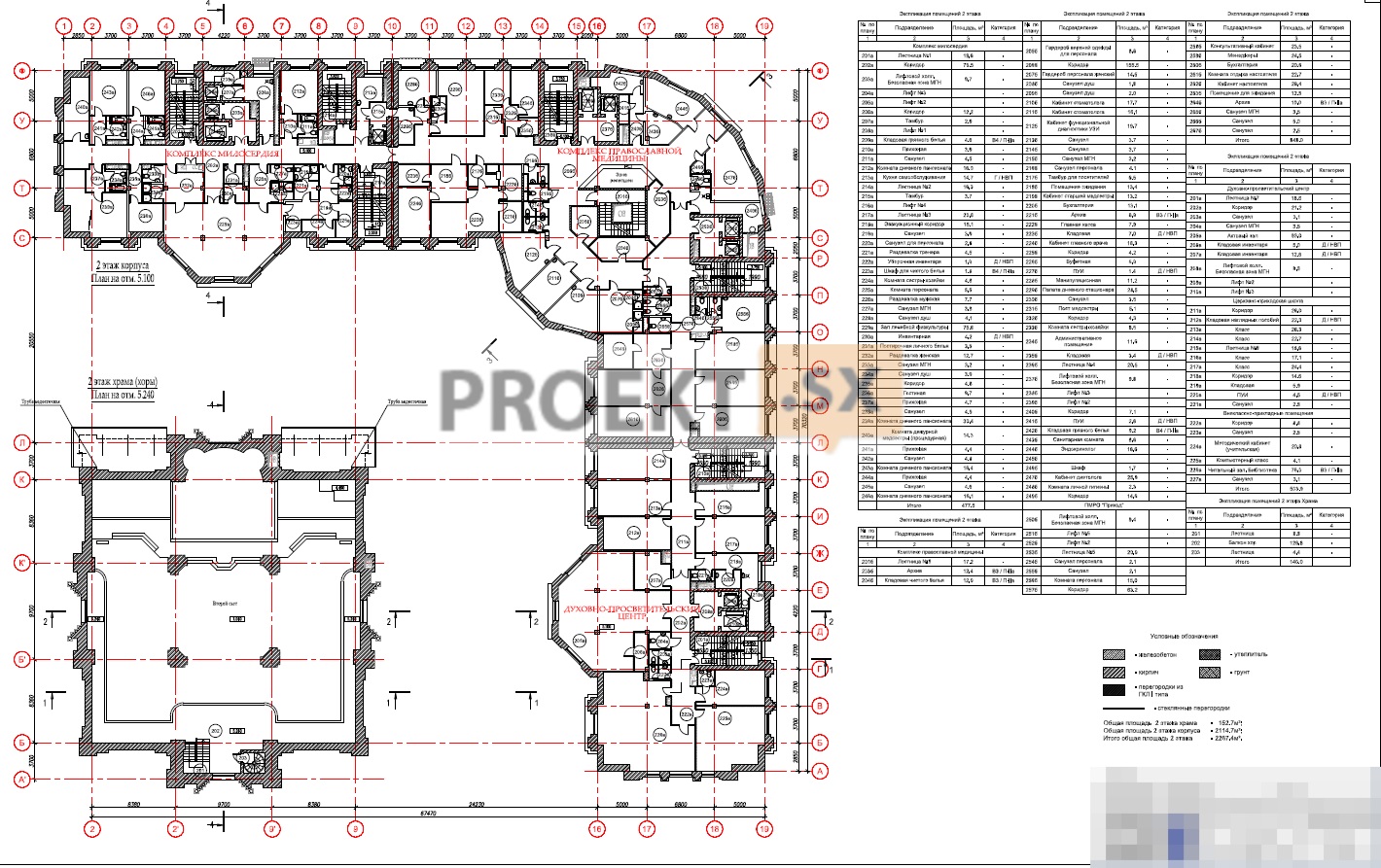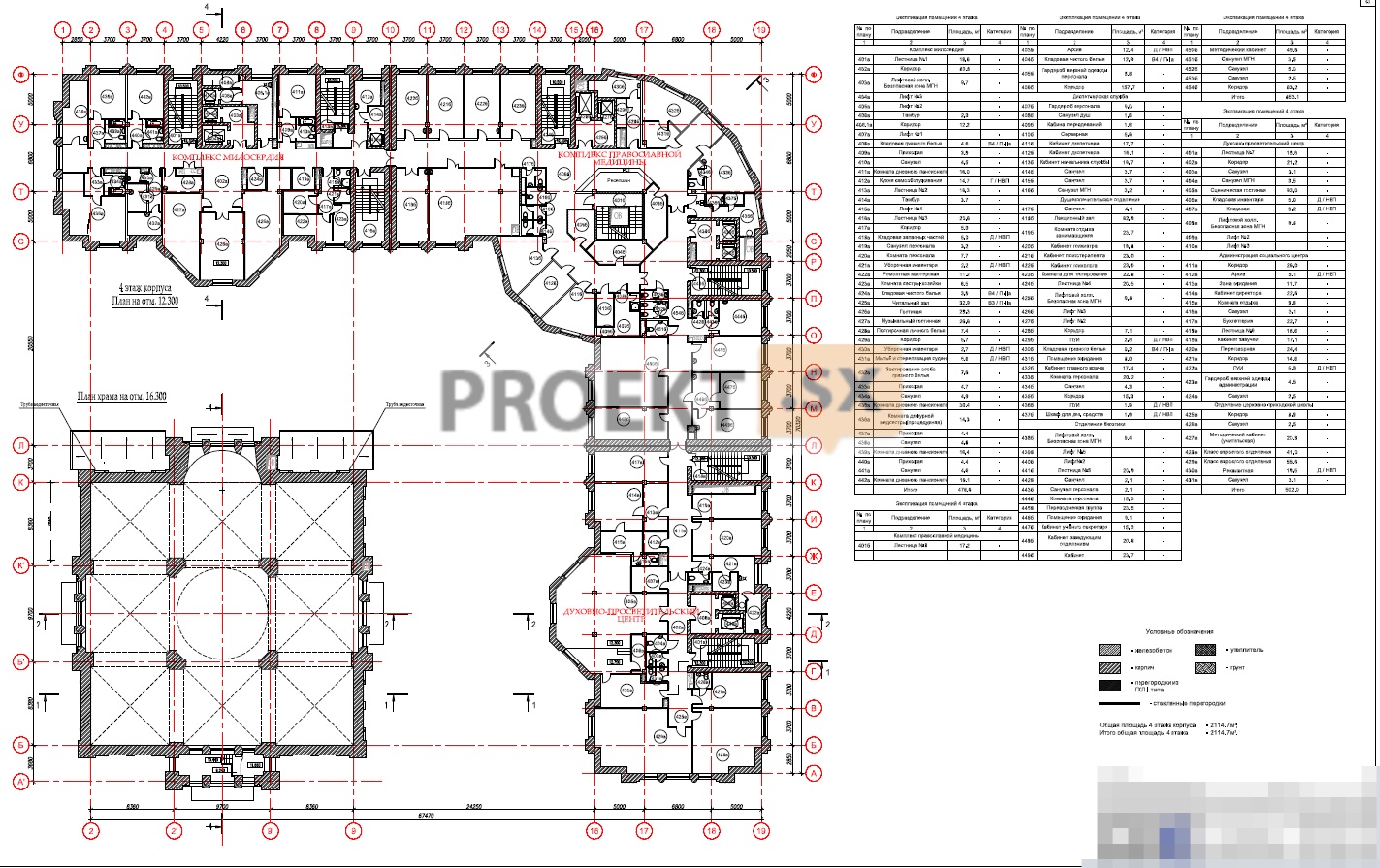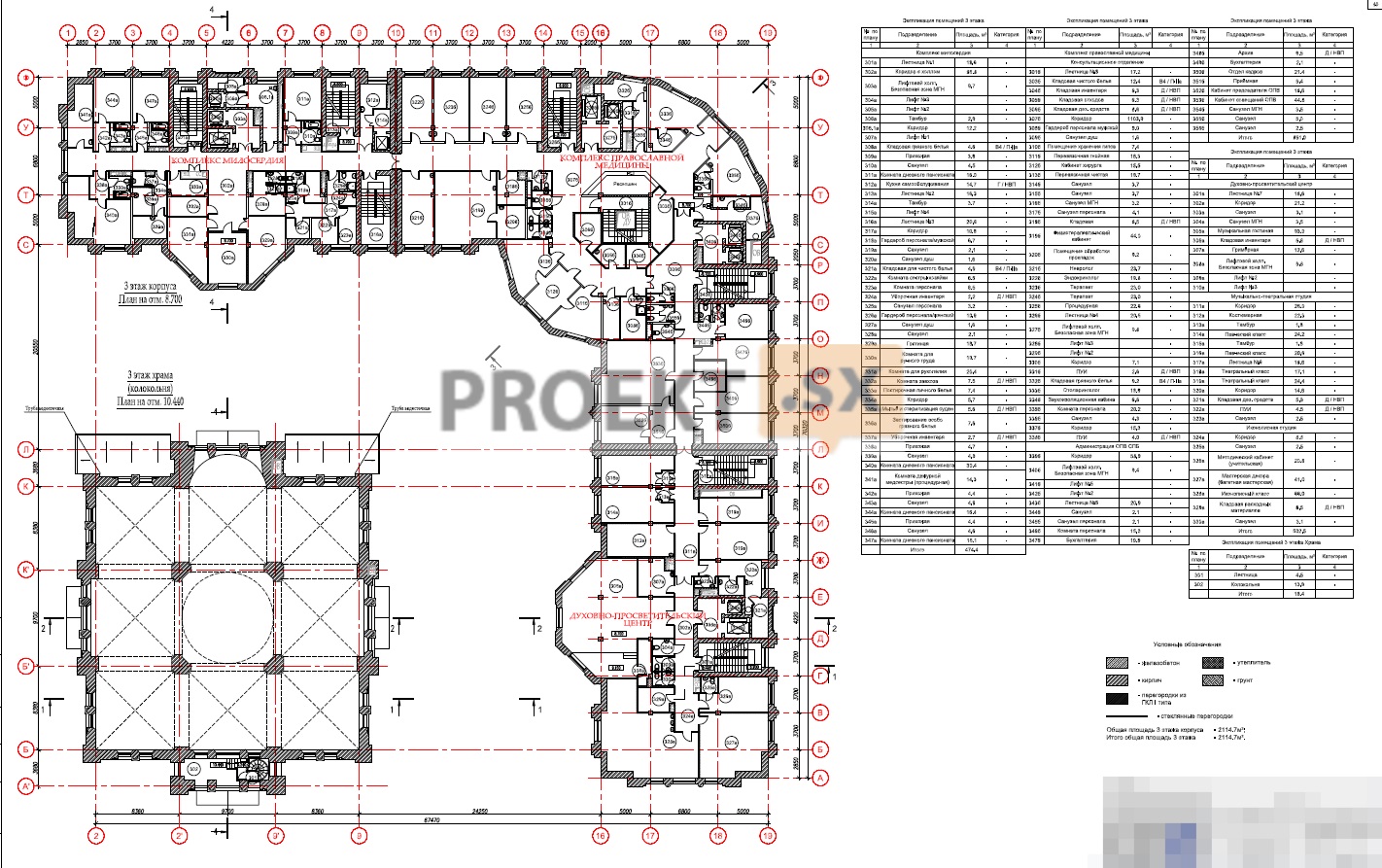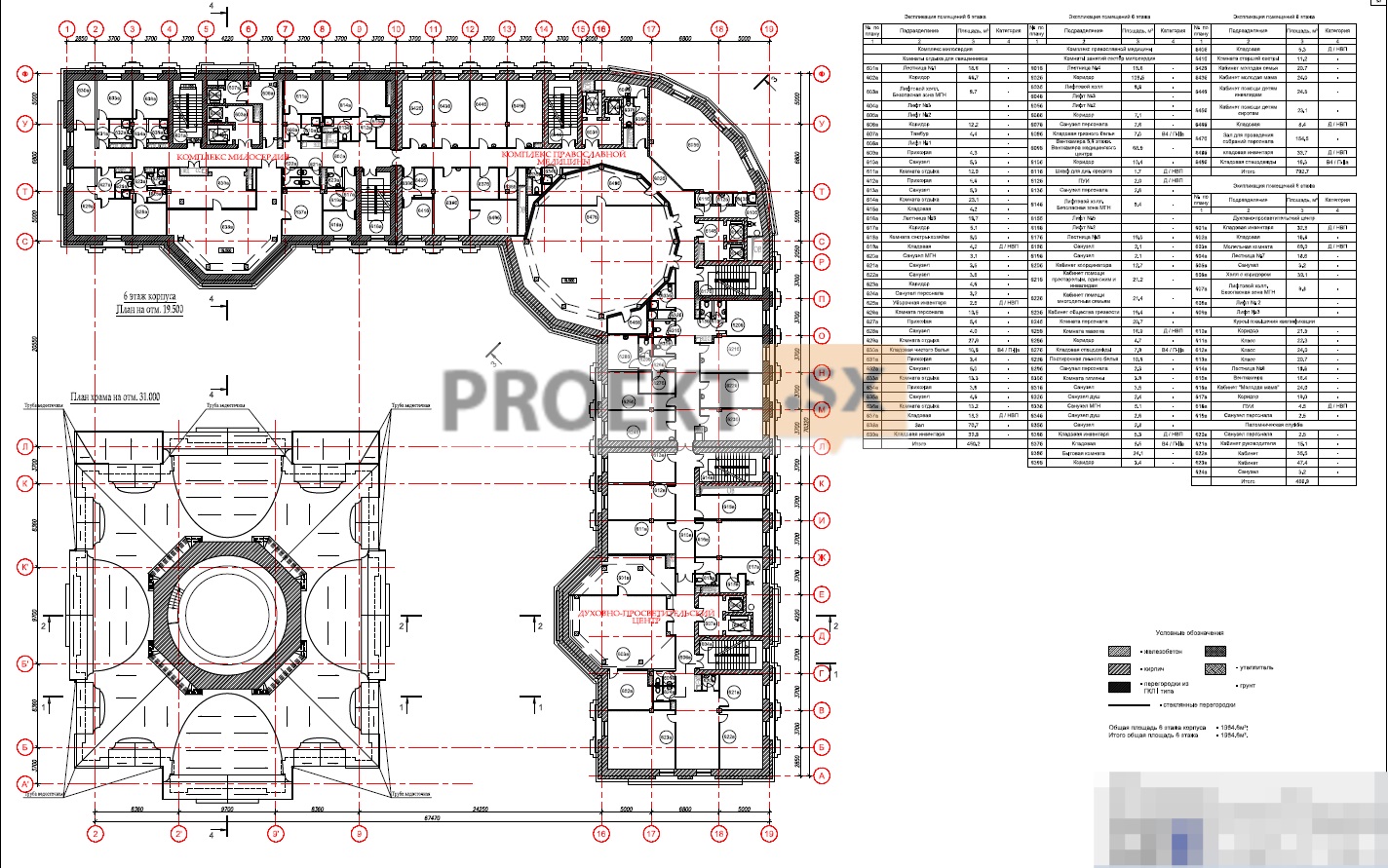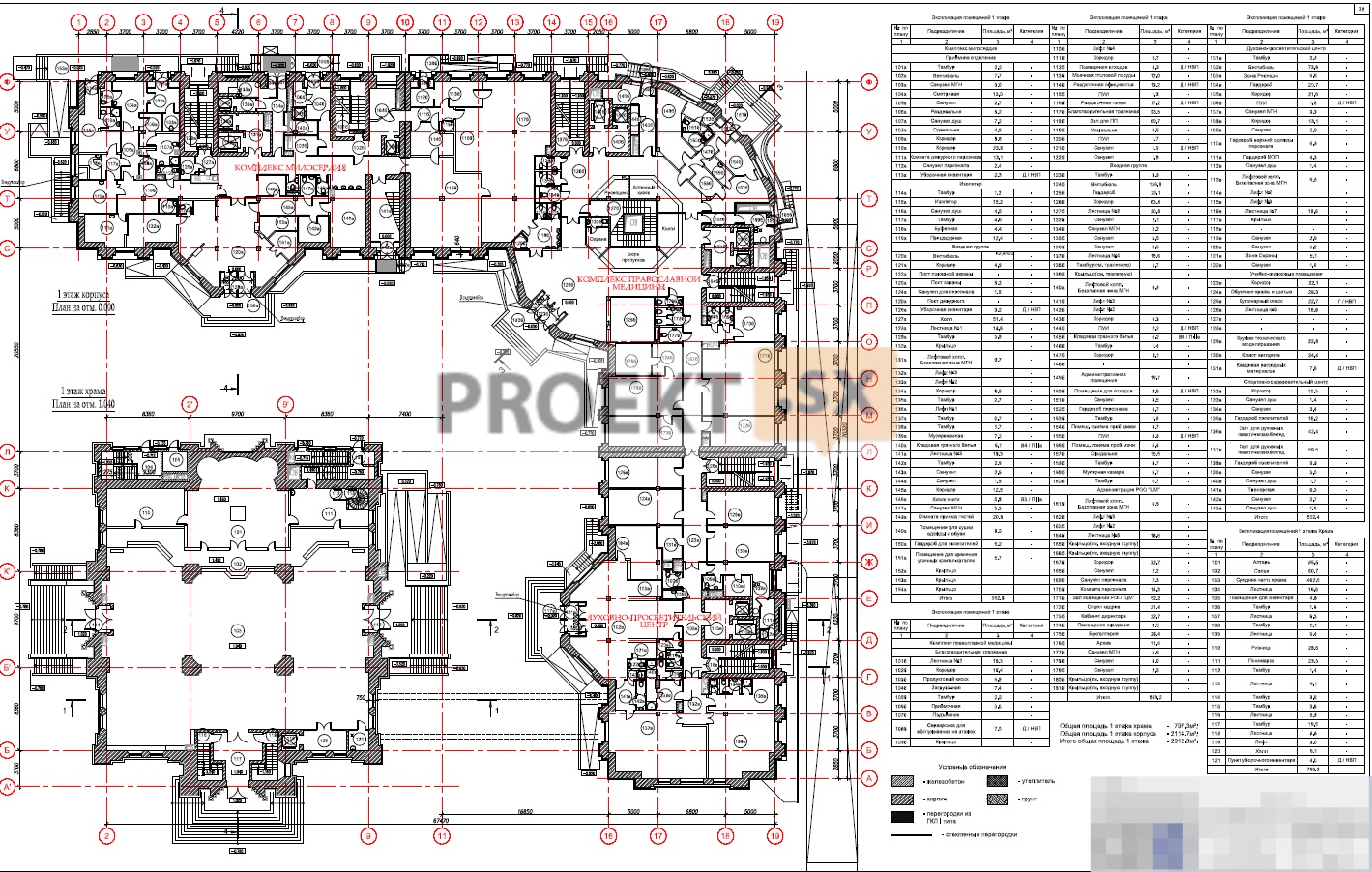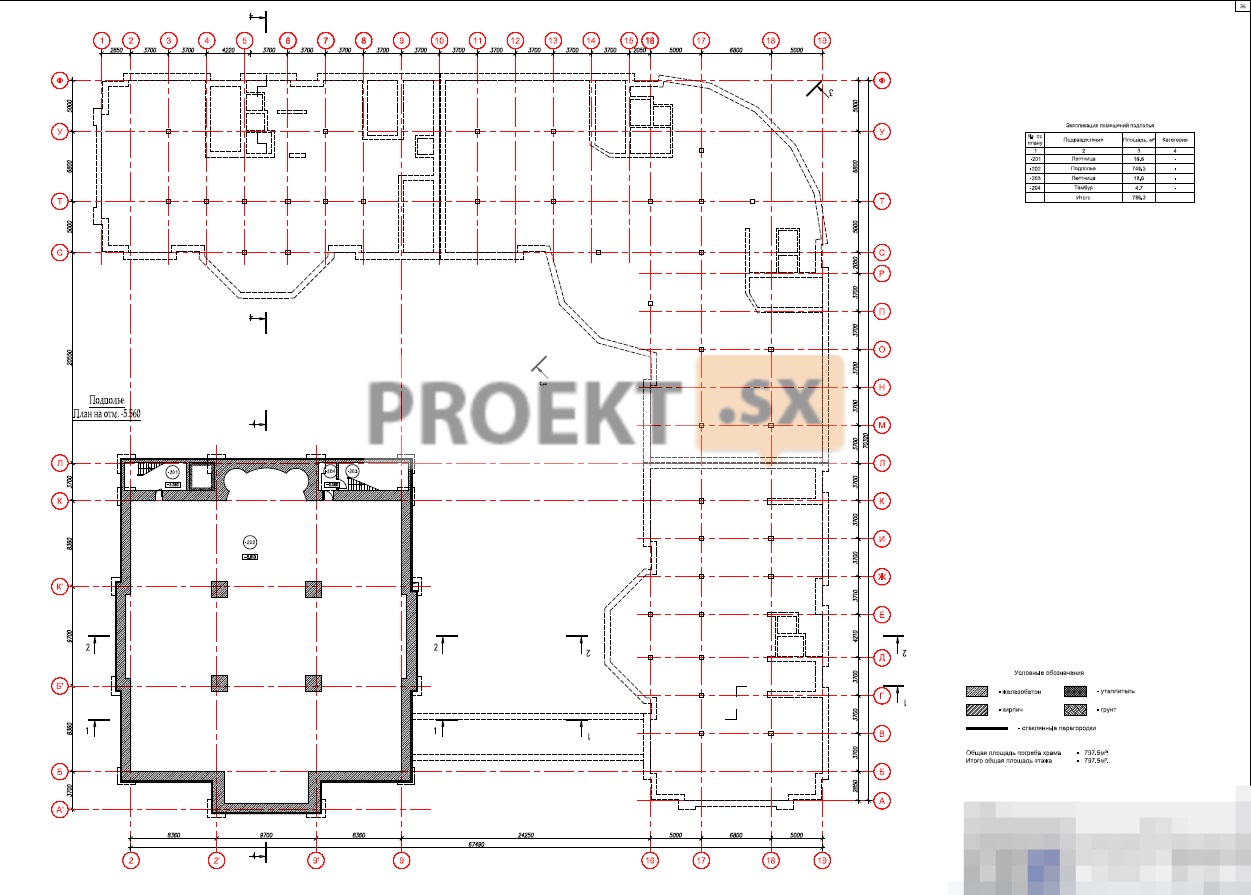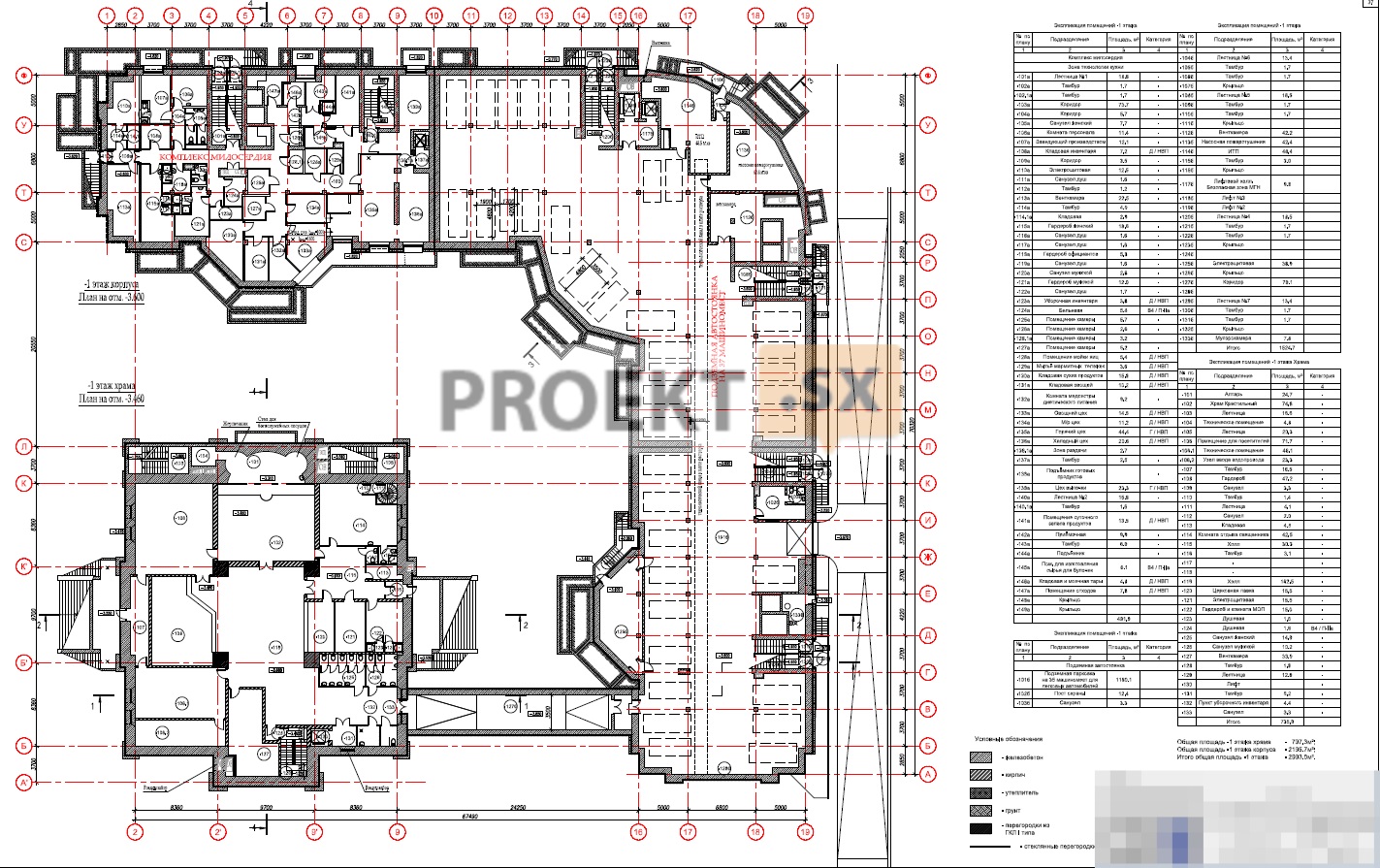Did not you find what you were looking for? Ask us! We have archives of 140 TB. We have all modern reuse projects and renovation projects for Soviet standard buildings. Write to us: info@proekt.sx
Mercy house project
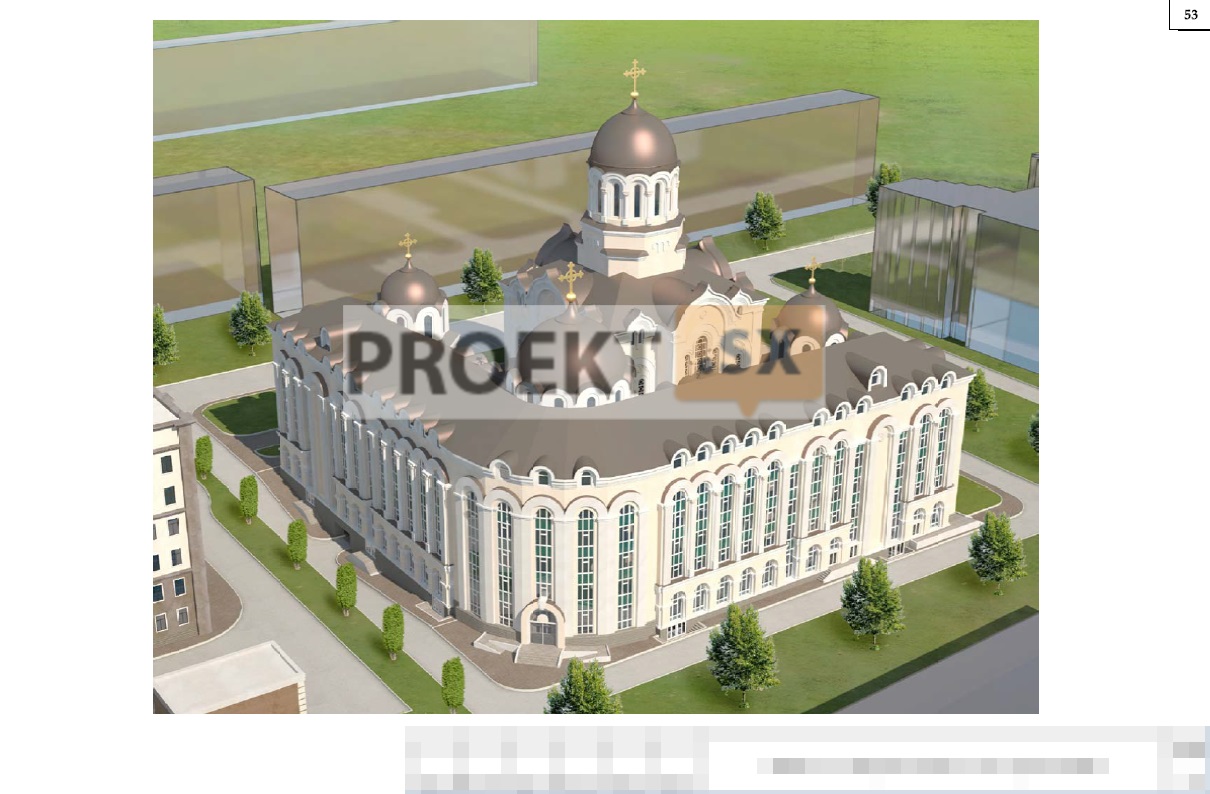
Technical and economic indicators
Plot area within the land allotment, ha: 1,0209
Building area, m2: 3995,0
Total building area, including, m2: 18082,8
total area of the Temple building, m2: 2544,8
total area of the PMSC building, m2: 15538,0
Building volume, including, m3: 106950,0
construction volume of the Temple building, m3: 33770,0
building volume of the MSTS building, m3: 73180,0
Floors of the Temple building fl.: 1 (five levels)
Number of storeys of the PMSC building, floor: 6+ upper and lower technical floors
Architectural and space-planning solutions
The design documentation provides for the site at the building address. Construction of a social security facility (house of mercy). The designed social security facility (house of mercy) consists of two compositionally and functionally related buildings: the Orthodox Medical and Social Center (hereinafter referred to as the PMSC) with a built-in underground parking with a capacity of 37 parking spaces, interconnected by an underground passage. For the relative mark of 0, 000, the level of the finished floor of the 1st floor of the PMSC was taken, corresponding to the absolute mark of + 26,37. The House of Mercy is designed to provide medical and social assistance to living citizens, to revive family values, to introduce them to work and a healthy lifestyle. The structural scheme of the main building of the House of Mercy of the PMSC is frame-wall with brick longitudinal and transverse load-bearing walls and reinforced concrete columns. The building is designed from three blocks separated by temperature - sedimentary seams. The building is six-storey with a basement floor and an upper technical floor (attic). The load-bearing elements of the roof and the domed part are steel structures with insulation and coating with titanium or copper oxide sheet. The domed part of the roof is rafter steel structures with insulation. The project documentation of the PMSC includes: a complex of mercy, a complex of Orthodox medicine and a spiritual and educational complex. The constructive scheme of the Temple is column-wall with brick load-bearing walls and columns, cross-vaulted reinforced concrete system of vaults. The domed part of the roof is made of steel structures with insulation and a coating of titanium or copper oxide sheet. The main facade of the complex is oriented to the street. PMSC building. The building is L-shaped in plan with maximum dimensions in the extreme axes of 70,32 x 70,32 m. The height of the buildings to the ridge is 28,33 m, to the top of the domes 38,72 m and 43,79 m. The PMSC includes three blocks (complexes): spiritual and educational, Orthodox medicine and mercy. The project documentation provides for the separation of blocks by double brick walls with doorways with doors on each floor. In the PMSC building, the design documentation provides for: On the ground floor (elev. 0,000), entrance groups with auxiliary premises, a reception department, an isolation ward, a grocery kiosk, sanitary facilities, an outpatient laboratory for receiving tests, a charity canteen, administrative premises, educational and circle rooms, a sports and fitness center were designed. On the second floor (e.g. 5.10) rooms of a day boarding house, a hall for spiritual conversations with clergymen, a block of the hostess, a nurse on duty, a self-service kitchen, a living room, sanitary facilities, an outpatient department, a parochial school for adults with an assembly hall and out-of-class - application rooms. On the third floor (e.g. 8.70) the rooms of the day boarding house with auxiliary rooms, utility rooms, block of the hostess, room of the nurse on duty, self-service kitchen, living room, sanitary units, advisory department, administrative premises, music and theater studio and icon painting studio, spiritual and educational center, archive . On the fourth floor (e.g. 12.30) rooms of a day boarding house with auxiliary rooms, utility rooms, an archive, a block of a hostess, a room for a nurse on duty, a self-service kitchen, a living room, sanitary facilities, a reception desk, a wardrobe, storage rooms for clean linen, a mental health department, a dispatch service, a bioethics department, administrative premises, stage living room, props, parochial school. On the fifth floor (e.g. 15.900) rooms of a day boarding house, a physiotherapy room with changing rooms, a block of a sister-hostess, a room for a nurse on duty, a self-service kitchen, a living room, sanitary facilities, rooms for sisters of mercy, a consulting department, a building maintenance service, a sisterhood management department, an editorial and publishing department, a lecture hall with ancillary rooms, a room for lecturers and a department of religious studies. On the sixth floor (e.g. 19.50 m), rest rooms for priests, rooms for the sister of the hostess and staff, pantries for linen, sanitary facilities, a conference room, study rooms, advanced training courses, a prayer room and a pilgrimage office were designed. On the upper technical floor (elev. 23.58) technical rooms are designed. Sanitary units, fire hazardous zones are provided on each floor. rooms for cleaning equipment. In the basement (elev. – 3.60 m) an underground parking lot for 37 cars, technical rooms for building operation and technological rooms for the kitchen were designed. The entrance and exit from the parking lot is designed along the ramps (ramps) from the southwestern side of the site. The provided technical premises in the car park are marked with type 1 fireproof partitions. with fire doors. For technological connection between the first floor of the building and the parking lot, elevator shafts (elevators) with a vestibule - locks with air overpressure in case of fire are provided. The vertical connection between the floors and evacuation from the building is designed by stairwells of the L1 type and one internal three-flight with an ascent to the fourth floor for technological connection. Flights of stairwells in the above-ground floors are provided with a width of 1,35 m. The building is equipped with elevators and garbage chutes. From the basement there are separate exits to the outside. Partitions - brick plastered. All premises with permanent residence of people are designed with natural light. Filling window openings - aluminum stained-glass windows and metal-plastic window blocks with double-glazed windows. The interior decoration of the premises is provided by materials that have hygienic and fire certificates of conformity for use. The roof is pitched with an external organized drain. Roof - galvanized steel. Domes - titanium oxide under copper. Finishing of facades - painting on a plastered surface The project documentation provides for all conditions for the movement of people with limited mobility. The building of the Temple is designed rectangular with ledges in the plan, the dimensions in the extreme axes are 33,82x26,42m. The height of the building from the planning ground level to the top of the cross is 58,64 m, to the top of the dome - 50,68 m. Building with basement and underground at el. - 5,56. The main entrances to the building are designed from three sides: the western facade, northern and southern. A building with brick walls and pilasters on a massive plinth lined with finished rusticated granite. The planes of the outer walls with pilasters, with narrow and high window openings. On three sides, the temple has double-leaf entrance doors framed by portals. The inner space of the temple ends with crowning vaults. The basement floor at elevation - 3,46 provides for the placement of the Altar, baptismal, sanitary facilities, technical premises (ITP, electrical panel, ventilation chamber, input unit), a church shop, a room for cleaning equipment, a priest's rest room. Entrances to the basement floor are designed along marches in the outer pits and along the inner staircase with a vestibule with air overpressure in case of fire. For the functional connection of the temple building with the PMSC building, an underground passage 3,5 m wide with vestibules - gateways and fire doors was designed. The above-ground part of the temple is designed from several tiers, on which a choir balcony and a belfry are designed, a technical balcony under the light drum with access to the roof. The temple building is designed from one floor, with different levels. At elev. 1,04, the premises of the main hall of the temple and the room for inventory were designed, at el. 1,490 altar, at el. 5,24 balcony for the choir. At elev.
Structural and space-planning solutions
The structural scheme of the Temple building is frame-wall. The temple is cross-domed, single-domed, designed in the form of a three-span (three-nave) arch-rack system, consisting of brick outer walls and inner pillars. External walls - from solid brick, 1030 mm thick, in niches - 770 mm thick, with mesh plastering and painting. The walls are with pilasters. Cornices - in areas with reinforcement and anchoring or reinforced concrete inclusions. The outer walls of the central light drum are made of solid brick, 770 mm thick, in the octagon zone - up to 1365 mm thick. The internal pillars are made of brick, designed with a complex shape, with a maximum section of 1940x1940 mm, with pilasters 770 and 1420 mm wide. The walls of the elevator shaft are made of bricks 250 mm thick, with rigid fastening to the walls of the building. The lintels of the outer walls are brick, arched, with a belt height per edge of at least 250 mm in accordance with the span of the opening. The outer walls of the basement - 910-1190 mm thick, made of monolithic reinforced concrete, in the freezing zone - with insulation and with a pressure wall made of monolithic reinforced concrete or brick, above the blind area - with natural stone trim. Basement columns - section 1550x1550 mm, made of monolithic reinforced concrete. The ceiling at the relative elevation of the top of the slab minus 3,610 is a continuous slab of monolithic reinforced concrete, 250 mm thick, with a rigid support on the walls and columns. The ceiling above the basement floor is a continuous slab of monolithic reinforced concrete 250 mm thick, with rigid support on beams with a cross section of 500x750 mm (h, taking into account the thickness of the slab) and basement walls. The overlap of the side compartments of the temple premises is a vaulted-arched structure made of monolithic reinforced concrete. The outline of the vaults is designed along an arc of a circle, with an L / 2 lifting boom, in the form of cross-sectional cylinders. Vaults - 140 mm thick, with rigid support on reinforced concrete beams-arches and hinged support on external brick walls. Beams - arches - three-span reinforced concrete with a width of 770 and 1420 mm, in the support zone - 4515 mm high, in the middle of the spans - 400 mm high. Beams - with hinged support on brick columns and walls. The covering of the side aisles of the Temple is a wooden truss system. Rafters - from a bar, with fastening to a wooden Mauerlat and reinforced concrete vaults. Rafters - treated with antiseptic and flame retardant. The lathing is wooden, the roof is made of galvanized sheet steel. The cover of the central light drum is a steel structure, designed in the form of a dome, in plan with an outer diameter of 12,51 m. Radially located rafters - bezraskosnye semi-arches, with belts of closed bent-welded profiles 80x80x6 mm, in the upper zone - with fastening to the central support ring of rolled channels, along the bottom - with support and transfer of thrust forces to the reinforced concrete belt. The lathing is wooden, the roof is made of sheet titanium oxide under copper. The design of the dome is insulated, from the side of the room it is covered with concrete on the grid for painting. Reinforced concrete supporting belt of the dome - a ring with an outer diameter of 12,51 m, with a cross section of 390-490x560 mm, supported by the light drum on the brick walls. Reinforced concrete support belt of the octagon - a ring with an internal diameter of 12,00 m, with a cross section of 1370x600 mm, supported by reinforced concrete supports 100 mm high, with load transfer through beams to brick pillars. The balcony of the choir is a 160 mm thick monolithic reinforced concrete slab supported by steel brackets. Brackets - from rolling channels No. 14 with fastening to the brickwork of the walls with anchors. Steel C245. Elements of internal stairs - prefabricated reinforced concrete and monolithic reinforced concrete. Porches and pits - from monolithic reinforced concrete, separated from the building by sedimentary seams. The reinforced concrete structures of the Temple building are made of concrete B30 (in the basement and in the zone of possible freezing - B30, W8, F150) and reinforcement A500C, A240. Brickwork of walls and pillars, lintels - from solid brick KR-r-po / 1NF / 175 / 2.0 / 35 GOST 530-2012 on mortar M100, with reinforcement. The spatial rigidity and stability of the Temple building is ensured by the box-shaped structure of the basement, the joint work of load-bearing brick walls and pillars, united by a hard disk of vaulted beams. The constructive scheme of the building of the Medical and Social Center is column-wall, consisting of load-bearing facade walls and columns along the internal axes. Along the length, the building is divided by temperature-sedimentary seams into three blocks with the construction of adjacent brick walls 510 mm thick. External walls - load-bearing, 640 mm thick, with pilasters, made of hollow bricks, with plastering, external walls of the plinth - solid bricks. Wall sections - 380 mm thick with external insulation. The outer walls of the basement - 640 and 540 mm thick - from monolithic reinforced concrete, in the freezing zone - with insulation, with a pressure wall made of monolithic reinforced concrete or brick, above the blind area - with natural stone trim. The inner walls of the basement - 510 and 380 mm, made of monolithic reinforced concrete. The internal walls of the stairs and the transverse walls in the zone of the expansion joint on floors 1-6 are load-bearing, 510 mm thick, made of solid brick. Columns - with a section of 400x400 mm from monolithic reinforced concrete, with a maximum step of 6,8x3,7 m. Ceilings - continuous slabs 220 mm thick from monolithic reinforced concrete, supported by columns and walls, in sections - on beams with a section of 400-600x600 (h) mm . To prevent freezing - the ends of the plates are insulated, in areas - with thermal inserts. Coverings - blocks - steel hip truss systems, consisting of racks, girders and layered rafters. Racks - from closed bent-welded profiles 100x100x6 mm. Runs - from rolling channels No. 20 and No. 24. Laminated rafters - from rolled channels No. 20, with a step of no more than 1,5 m, below - with rigid fastening to the reinforced concrete belt of the outer walls, with hinged support on the reinforced concrete floor slab above the sixth floor and steel purlins and racks. Steel C255. The lathing is wooden, the roof is made of galvanized sheet steel. The cover is insulated. Coverings of light drums of blocks 2.1-2.3 - steel structures in the form of domes, with support and transfer of thrust forces to reinforced concrete belts. Dome structures - from closed bent-welded profiles: in block 2.2 - section 80x80x6 mm, in block 2.1 and 2.2 - section 60x60x6 mm, with a support ring for attaching the cross - from rolled channels. Steel C255. The lathing is wooden, the roof is made of sheet titanium oxide. The coating is insulated, from the side of the room - with concreting on a grid for painting. Reinforced concrete supporting belts of domes: in block 2.2 - 750 mm high; in block 2.1 and 2.3 - 520 mm high; with light drums resting on brick walls. Reinforced concrete supporting belts of light drums are polyhedral in plan, 600 mm high, supported by reinforced concrete columns. Elements of stairs: marches - prefabricated reinforced concrete; platforms - from monolithic reinforced concrete with a thickness of 180 and 220 mm. Lintels - prefabricated reinforced concrete and solid bricks. Brick lintels - arched. The elevator shafts are made of brick, with a wall thickness of 250 mm, in the basement they are made of monolithic reinforced concrete. Reinforced concrete structures of the building of the Medical and Social Center - from concrete B30, (in the basement and in the zone of possible freezing - B30, W8, F150) and reinforcement A500C, A240. Brickwork of walls - from solid brick KO-r-po / 1NF / 175 / 2.0 / 35 GOST 530-2012 and hollow brick KO-r-pu / 1NF / 175-150 / 1.4 / 35 GOST 530-2012 on mortar M100, on mortar M100, with reinforcement. The spatial rigidity and stability of the blocks of the Medical and Social Center is ensured by the box-shaped structure of the basement, the joint work of load-bearing brick walls and reinforced concrete columns of floors united by hard disks. The level of responsibility of the building of the Medical and Social Center is the second (normal). The estimated service life is assumed to be at least 100 years. The level of responsibility of the Temple building with a capacity of up to 1200 people is 1b (high). The estimated service life of the building is assumed to be at least 100 years. Structural calculations were performed using the SCAD v.11.3 software package in a finite element model, taking into account the joint work of the building, foundations and foundation. The required fire resistance of reinforced concrete structures is confirmed by calculations, except for the columns of the parking lot, which are additionally protected from fire impact. The mark of the floor of the first floor of the building of the Medico-Social Center, corresponding to the absolute mark of 0,000, was taken as 26.37. The foundations of the buildings are designed in accordance with the results of engineering and geological surveys. The piles of the Temple building are prefabricated reinforced concrete, composite, trapezoidal, with a section of 40x40 cm, a length of 22 m (14,6 m from the bottom of the grillage), immersed by indentation from the surface of the earth. The absolute mark of the bottom of the piles is 3.86. The piles of the building of the Medical and Social Center are prefabricated reinforced concrete, trapezoidal, with a section of 40x40 cm, 16 m long, immersed by indentation from the bottom of the pit. The absolute mark of the bottom of the piles is 6.00.


